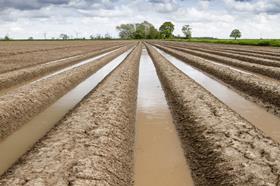
This summer, brassicas were in the spotlight for the wrong reasons, with some farms in Lincolnshire recording the equivalent of three months’ rainfall in just a week, causing significant shortages. Now it is potato growers’ turn to suffer, with recent wet weather during lifting hampering efforts to get the crop out of the ground.
In areas that were hit by prolonged, heavy rainfall, such as the North West, AHDB analyst Aidan Wright reports that there are concerns for the crop that’s still in the ground. “With a significant proportion of the crop going into store wet, there is a risk we could see higher levels of waste and breakdown, limiting the amount of useable crop,” he says. “This could support prices in the latter half of the season.”
Greenvale’s Andy Clarkson believes skin finish, rot and greening will be the main weather-related challenges this season for product quality, but he notes that the recent rainfall has “alleviated concerns on bruising and damage levels associated with the previously dry conditions in the East”. Yield prospects remain good, he adds, with “average to slightly higher than average yields for the GB”, however he stresses that there will of course be the usual regional variations.
Echoing this, Branston’s managing director James Truscott says it’s a “mixed” picture for UK producers. “The South West has done much better than in recent years; Scotland looks to be in good shape with strong yields; and the East is patchier, with certain areas that received the extreme rainfall in June having a very tough time with poor yields and failed fields. The recent wet weather has delayed harvest so we won’t know the full picture for a few weeks yet.”
This contrasts with the situation earlier in the season, when the sector was still feeling the effects of last year’s drought. “Kinder growing conditions over the summer appear to have allowed yields to recover from last year,” says Wright. “This has meant that, at the start of this season, prices fell. Higher availability of free-buy supplies was met with limited demand coming out of the drought, putting pressure on prices.” Moving forward, prices for the rest of the season will be determined by how well the current crop stores.
While the weather is ever-changing, one trend that looks set to continue in fresh potatoes is the reduction in pack sizes. According to Kantar, sales of 500g-1kg packs have risen by around 11 per cent year on year, with 1.5-2kg packs also growing at approximately seven per cent. By contrast, large packs of 3kg or more are declining fastest.
The issue has been discussed for a number of years now, and Branston’s MD says “the rationale for it is clear” – matching pack size to household size and consumption levels, as well as addressing concerns about food waste – however he is concerned the move could have a “dramatic impact” on volumes sold. Despite this, he remains principled on the issue, saying: “Fundamentally, we are believers in doing what is right for the consumer. This is the right thing to do in the long term.”
Another factor having an impact on sales volumes is a decline in potatoes’ popularity among older shoppers – although it is important to note that the over-65s are still the biggest consumers, accounting for 28 per cent of all potato occasions. “Over the past year, older households have been buying fewer potatoes,” reports AHDB retail insight analyst Zoe Avison, and this is driving retail volume declines where sales were down 2.2 per cent year on year, according to Kantar data for the 52 weeks to 8 September. Against this, “younger households have actually increased the amount of potatoes they are buying,” says Avison, “but it isn’t enough to offset declining sales to older households.”
Clarkson adds that while purchase volume per trip has dropped in the past 12 months, with the number of category promotions falling by around nine per cent, some retailers are now promoting a little more and “we are seeing this decline stemmed in the short term”.
When it comes to the sales performance of different potato types, maincrop potatoes have suffered most, with volumes down 6.4 per cent (51,500t) year on year, according to Kantar. Baking potatoes have offset this decline somewhat, with sales up 25,600t.
Jackets have proven particularly popular with younger consumers, reports Avison. “Pre-family and young-family households bought a combined 10,400 extra tonnes this year compared to last,” she says.






No comments yet